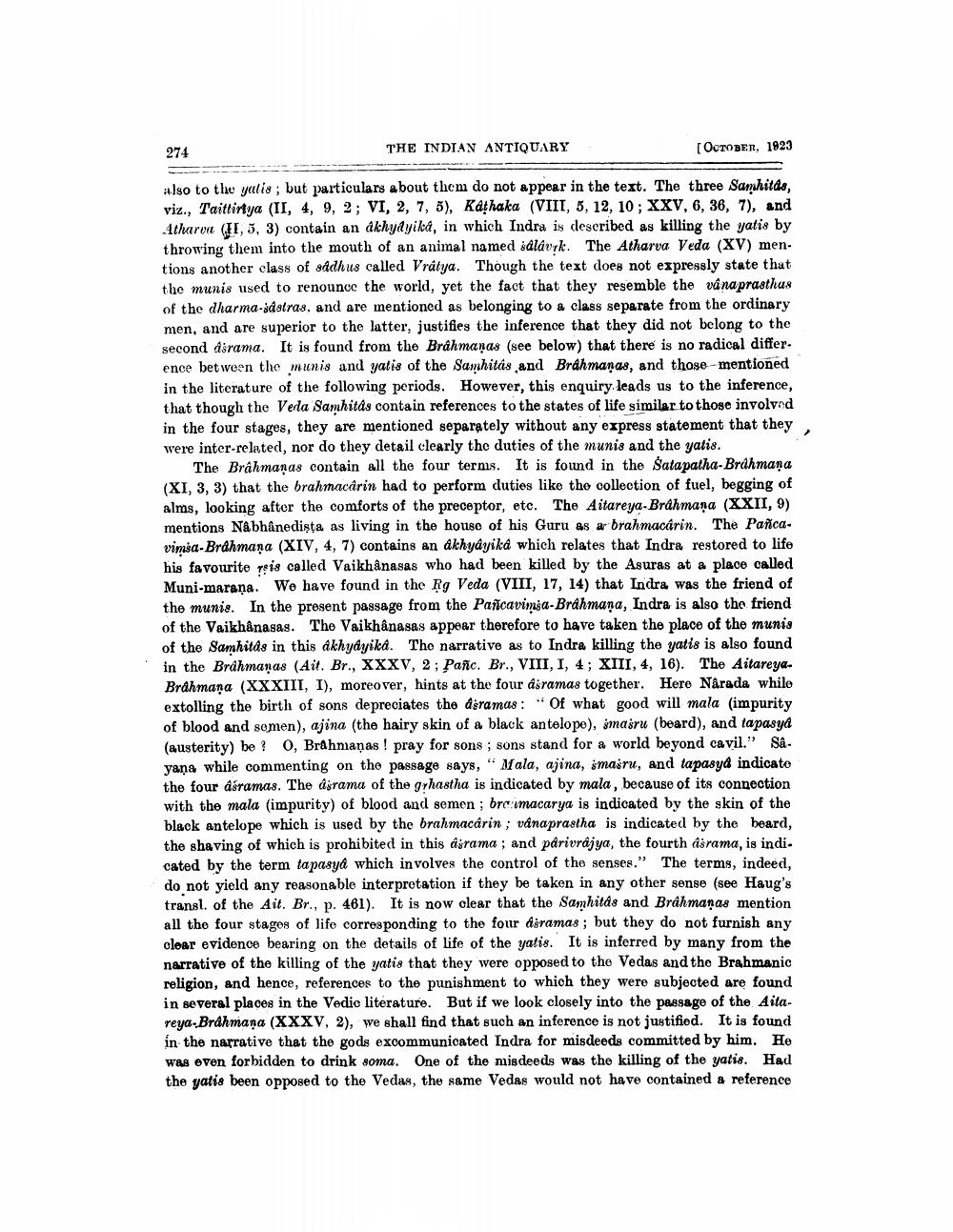________________
274
THE INDIAN ANTIQUARY
[OCTOBER, 1923
also to the yalis; but particulars about them do not appear in the text. The three Samhitas, viz., Taittirtya (II, 4, 9, 2; VI, 2, 7, 5), Kathaka (VIII, 5, 12, 10; XXV, 6, 36, 7), and Atharva (IL, 5, 3) contain an akhydyika, in which Indra is described as killing the yatis by throwing them into the mouth of an animal named salavyk. The Atharva Veda (XV) men. tions another class of sådhus called Vrátya. Though the text does not expressly state that the munis used to renounoc the world, yet the fact that they resemble the vâna prasthus of the dharma-sdstras, and are mentioned as belonging to a class separate from the ordinary men, and are superior to the latter, justifies the inference that they did not belong to the second asrama. It is found from the Brâhmanas (see below) that there is no radical differ. ence between the munis and yatis of the Samhitas and Brahmaņas, and those mentioned in the literature of the following periods. However, this enquiry leads us to the inference, that though the Verla Samhitas contain references to the states of life similar to those involved in the four stages, they are mentioned separately without any express statement that they were inter-related, nor do they detail clearly the duties of the munis and the yatis.
The Brahmanas contain all the four terms. It is found in the Satapatha-Brahmana (XI, 3, 3) that the brahmacárin had to perform duties like the oollection of fuel, begging of alms, looking after the comforts of the preceptor, etc. The Aitareya-Brahmaņa (XXII, 9) mentions Nabhanedista as living in the house of his Guru as a brahmacárin. The Panca. vimša-Brahmana (XIV, 4, 7) contains an akhyāyika which relates that Indra restored to life his favourito rpis called Vaikhanasas who had been killed by the Asuras at a place called Muni-marana. Wo have found in the Rg Veda (VIII, 17, 14) that Indra was the friend of the munis. In the present passage from the Pañcavimša-Brahmana, Indra is also the friend of the Vaikhånasas. The Vaikhånasas appear therefore to have taken the place of the munis of the Samhitas in this akhydyika. The narrative as to Indra killing the yatis is also found in the Brahmanas (Ait. Br., XXXV, 2; Pañc. Br., VIII, I, 4; XIII, 4, 16). The AitareyaBrahmana (XXXIII, I), moreover, hints at the four asramas together. Hero Narada while extolling the birth of sons depreciates the agramas: "Of what good will mala (impurity of blood and somen), ajina (the hairy skin of a black antelope), masru (beard), and tapasya (austerity) be? O, Brahmaņas ! pray for sons ; sons stand for a world beyond cavil." Så yana while commenting on the passage says, “ Mala, ajina, smasru, and tapasyd indicate the four asramas. The asrama of the grhastha is indicated by mala, because of its connection with the mala (impurity) of blood and semen ; bre macarya is indicated by the skin of the black antelope which is used by the brahmacárin ; vânaprastha is indicated by the beard, the shaving of which is prohibited in this ásrama ; and pärivrajya, the fourth asrama, is indi. cated by the term tapasya which involves the control of the senses." The terms, indeed, do not yield any reasonable interpretation if they be taken in any other sense (see Haug's transl. of the Ait. Br., p. 461). It is now clear that the Samhitds and Brahmanas mention all the four stages of life corresponding to the four asramas ; but they do not furnish any oloar evidence bearing on the details of life of the yatis. It is inferred by many from the narrative of the killing of the yatis that they were opposed to the Vedas and the Brahmanic religion, and hence, references to the punishment to which they were subjected are found in several places in the Vedio literature. But if we look closely into the passage of the Aitareya-Brahmana (XXXV, 2), we shall find that such an inference is not justified. It is found in the narrative that the gods exoommunicated Indra for misdeeds committed by him. He was even forbidden to drink soma. One of the misdeeds was the killing of the yatis. Had the yatis been opposed to the Veday, the same Vedas would not have contained a reference




